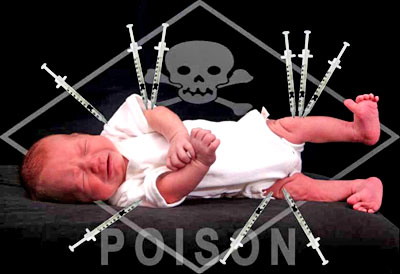PURE EVIL: Notorious vaccine company covered up SIDS clusters by strategically distributing suspect vaccine lots around the country
By ljdevon // 2023-08-09
Tweet
Share
Copy

Back in 1979, a vaccine company named Wyeth Laboratories was challenged by the Tennessee Department of Health over a vaccine lot that was suspected in multiple cases of sudden infant death syndrome (SIDS). At the time, Wyeth knew (in their internal communications) that their DTP vaccine was causing SIDS, but instead of pulling their product from the market and making a safer vaccine, the company came up with a strategic vaccine distribution plan to conceal potential SIDS clusters across the United States. In response to the uptick in SIDS cases, Wyeth came up with a vaccine distribution plan that would re-route bad vaccine lots from one community to multiple cities across the country to conceal SIDS clusters and dilute the incidence of serious side effects.

Wyeth’s DTP vaccine tied to SIDS clusters in Tennessee in 1978-1979
In March 1979, the Tennessee Department of Health reported four cases of sudden and unexplained death in infants (SIDS). These four cases of SIDS were reported over the course of five months; health authorities took these cluster cases very seriously back in the 70s, before SIDS became normalized around the country. The four deceased infants had one thing in common: they all died within 24 hours after receiving their first DPT vaccine. The DPT vaccine is a three-dose combination vaccine that contains antigens for diphtheria, pertussis, and tetanus. The vaccine is designed to protect children against two rare infections and one common infection that can be very serious if the infections are acquired at a young age. Although the vaccines are credited for a complete eradication of the targeted diseases, rates of infection and severe disease for diphtheria, pertussis, and tetanus were in major decline prior to 1949. At the time, the DTP vaccine contained a powerful adjuvant that caused bad reactions in some infants. The four cases of SIDS at the Tennessee Department of Health were all derived from the same lot (lot A). In 1978 and 1979, lot A was the predominant DTP lot used in pediatrician’s offices throughout Tennessee. A subsequent investigation into lot A confirmed that there was a greater than expected temporal relation between the specific DPT vaccine lot and SIDS cases. Instead of addressing this serious public health issue, Wyeth came up with a new distribution plan. On August 27, 1979, senior management staff Wyeth discussed “the merits of limiting distribution of a large number of vials from a single lot to a single state, county or city health department.” Wyeth allocated vaccine lots in a manner that was designed to leave the maximum variety of lot numbers in distribution centers across the United States. The company ordered its distributors to limit orders of one lot to just 2000 vials, to maximize the variety of lot numbers in a community. In this way, health departments would not be able to detect vaccine safety signals in a community if a bad vaccine lot caused SIDS clusters again. Wyeth was never held accountable for their nefarious vaccine lot distribution policies; they were eventually bought out by Pfizer.
The link between DTP vaccine and SIDS cases goes on for decades
The DTP vaccine had been implicated as a cause of SIDS as far back as 1933. That year, two infants received the DTP vaccine shortly after birth and died within two hours of their second dose. One child died at 11 days old after the second dose and the other child died at age four, after their second dose. The DTP-SIDS connection would continue, even after serious safety signals emerged in Tennessee. Another case report documented the sudden death of twin infants. One died at 5 months old, within three hours of the DTP shot. The other twin died at 10 months old, within 24 hours of the DPT shot. In another case report, six additional children were reported dead within 48 hours of the DTP vaccine. As the contentious topic received more attention, a 1986 case report looked at another 150 deaths post-DPT vaccination. This case report included 37 authors across 12 countries. Most of the infant deaths (75%) occurred within 72 hours of the shot. The mechanism behind DTP vaccines causing SIDS has been studied extensively. Douglas Miller, a neuropathologist and expert witness on SIDS cases, found that vaccines can cause an increase in cytokine production, causing fever that inhibits the 5-HT activity of neurons in the medulla. This causes prolonged apneas that interfere with auto-resuscitation in infants. Research by Matturri et al. finds that aluminum adjuvants in the vaccines cross the blood-brain barrier only to induce “neuronal molecular alteration in DNA, RNA, and proteins of brain stem neurons regulating vital functions, with consequent fatal disorganization of respiratory control in particularly predisposed infants.” The research of Miller and Goldman hypothesized that there are biochemical and synergistic toxicity when multiple vaccines are administered concurrently. In the U.S., the DTP vaccine was eventually replaced with the acellular DTaP vaccine in 1996, while the original DTP vaccine continues to be used on vulnerable infants around the world. The newer acellular DTaP combination shot contains a slightly less reactive adjuvant. However, to this day, SIDS cases continue to occur predominantly 72 hours after routine childhood vaccinations. Despite these serious life-and-death issues for the most vulnerable, the safety of the entire childhood vaccine schedule continues to go unstudied. U.S. regulatory agencies continue to ignore serious safety signals with the childhood vaccine schedule and the bloody trail of medical malfeasance and wrongful death directly associated with DTP vaccines. Sources include: Inversionism.substack.com NCBI.NLM.NIH.gov Amazon.com NCBI.NLM.NIH.gov [PDF] Torch WC. 1982. Diphtheria-pertussis-tetanus (DPT) immunization: a potential cause of the sudden infant death syndrome (SIDS) (abstract). American Academy of Neurology, 34th Annual Meeting, April 25-May 1, 1982. Neurology 32(4, part 2):A169-170. Torch WC. 1986. Characteristics of diphtheria-pertussis-tetanus (DPT) postvaccinal deaths and DPT-caused sudden infant death syndrome (SIDS): a review (abstract). Neurology 36(Suppl. 1):148 Scholar.Google.com IngentaConnect.com Journals.SagePub.com ScienceDirect.comTweet
Share
Copy
Tagged Under:
inflammation vaccines corruption poison conspiracy aluminum Vaccine deaths deception immunizations medical fraud Dangerous Medicine infant health cytokines adjuvant SIDS badhealth badmedicine compounding toxicity apnea vaccine distribution medical malfeasance respiratory control SIDS clusters
You Might Also Like
Escalating tensions could spark Russia-NATO war at sea
By Richard Brown // Share
By News Editors // Share
WHAT? Book about Maui fires published BEFORE they even finished burning
By Ethan Huff // Share
New boss at Project Veritas FIRES everyone, complete CHAOS ensues
By Ethan Huff // Share
Recent News
North Korea advances nuclear submarine program as Kim Jong Un oversees missile tests
By kevinhughes // Share
USCIS touts historic immigration enforcement under Trump administration
By willowt // Share
Nvidia strengthens AI dominance with strategic Groq talent acquisition and licensing deal
By kevinhughes // Share
Landmark study links even light alcohol use to soaring mouth cancer risk
By avagrace // Share











